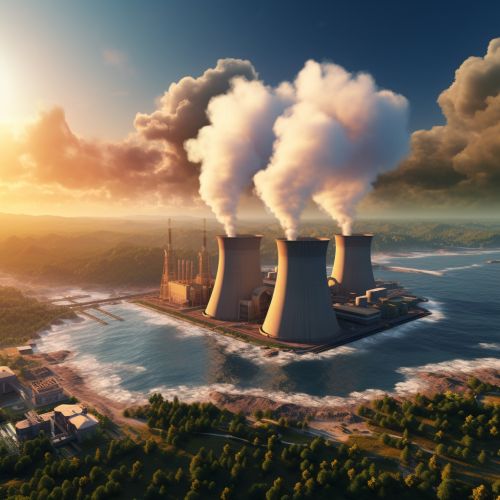Nuclear age
Introduction
The Nuclear Age is a period in human history characterized by the development and proliferation of nuclear technology. This era began with the discovery of nuclear fission in the late 1930s and was solidified with the detonation of the first atomic bomb during World War II. The Nuclear Age has had profound effects on global politics, warfare, energy production, and scientific research.

Discovery and Early Development
The Nuclear Age can be traced back to the late 19th and early 20th centuries, when scientists began to explore the properties of atoms. The discovery of radioactivity by Henri Becquerel in 1896, and subsequent research by Marie Curie and Pierre Curie, laid the groundwork for understanding the immense energy contained within the atomic nucleus.
In 1938, German chemists Otto Hahn and Fritz Strassmann discovered nuclear fission, the process by which an atomic nucleus splits into two or more smaller nuclei, releasing a large amount of energy. This discovery, further developed by physicists Lise Meitner and Otto Frisch, paved the way for the development of nuclear weapons and nuclear power.
The Manhattan Project and the Atomic Bomb
The most significant early application of nuclear technology was the development of the atomic bomb during World War II. The Manhattan Project, a secret U.S. government research project, produced the first nuclear weapons. The project was led by physicist Robert Oppenheimer and involved thousands of scientists and engineers at research facilities across the United States.
The first successful test of an atomic bomb, codenamed "Trinity," took place in July 1945. The U.S. subsequently used atomic bombs against the Japanese cities of Hiroshima and Nagasaki in August 1945, leading to Japan's surrender and the end of World War II.
The Cold War and Nuclear Arms Race
The end of World War II marked the beginning of the Cold War, a period of political and military tension between the United States and the Soviet Union. Central to this conflict was the nuclear arms race, as both superpowers sought to develop larger and more powerful nuclear arsenals.
The arms race led to the development of hydrogen bombs, which are hundreds of times more powerful than atomic bombs. The U.S. tested the first hydrogen bomb in 1952, and the Soviet Union followed suit in 1953. The arms race also spurred advances in missile technology, culminating in the development of intercontinental ballistic missiles (ICBMs) capable of delivering nuclear warheads anywhere in the world.
Nuclear Power and Energy
In addition to its military applications, nuclear technology has been used extensively for peaceful purposes, most notably in the generation of electricity. The first nuclear power plant was built in the Soviet Union in 1954, and the U.S. followed with its own plant in 1957.
Nuclear power provides a significant portion of the world's electricity. It is considered a clean energy source because it does not produce greenhouse gas emissions. However, it also poses significant challenges, including the risk of accidents, the disposal of radioactive waste, and the potential for the proliferation of nuclear weapons.
The Modern Nuclear Age
The modern Nuclear Age is characterized by a complex interplay of technological advancements, political dynamics, and societal attitudes towards nuclear technology. While the number of nuclear weapons has decreased since the height of the Cold War, the threat of nuclear warfare remains a significant global concern.
At the same time, the role of nuclear power in addressing climate change is a topic of ongoing debate. While some view nuclear energy as a necessary part of a low-carbon future, others point to the risks and challenges associated with nuclear power.
